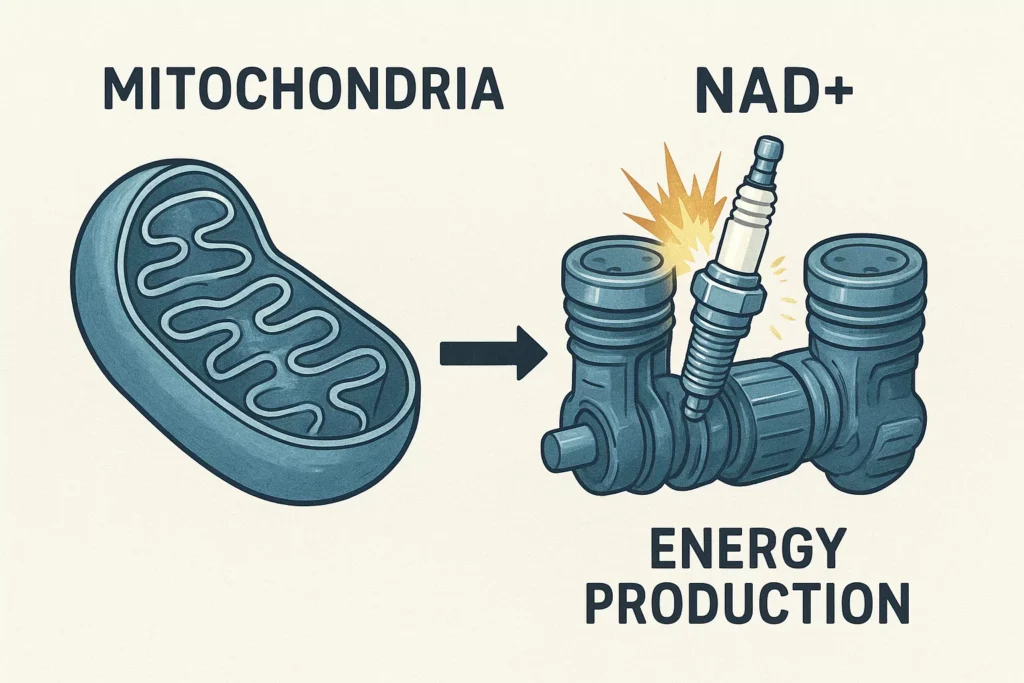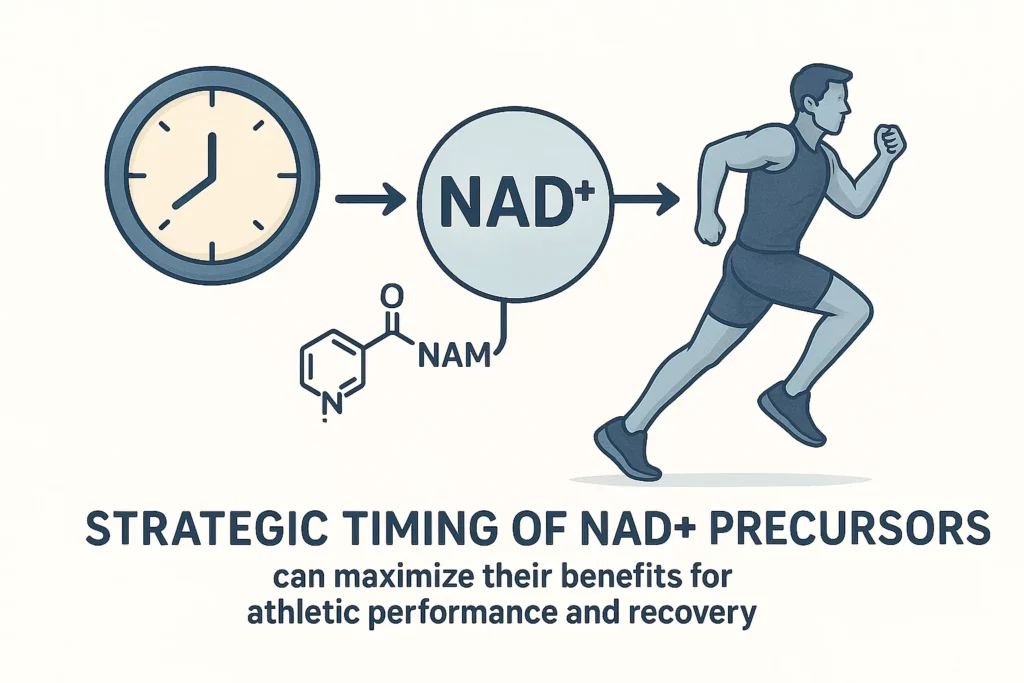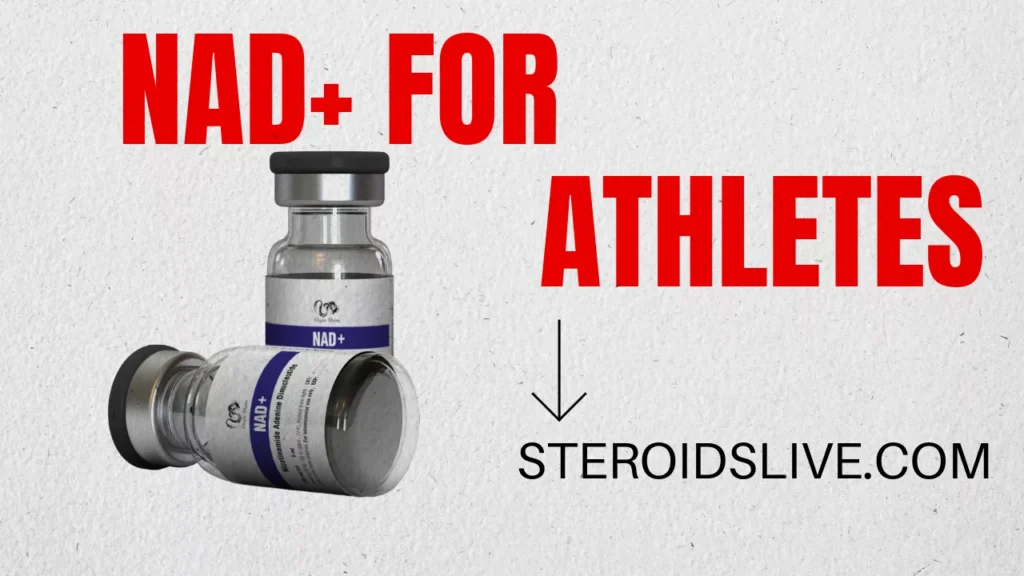You’ve probably seen NAD+ touted as the latest anti-aging miracle. But for athletes, this coenzyme is far more than a longevity supplement—it’s the literal currency of energy production that can dictate your performance ceiling and recovery speed. Let’s shift the narrative from anti-aging to athletic performance.
NAD+ 101: The Cellular Currency of Energy
NAD+ (Nicotinamide Adenine Dinucleotide) isn’t a vitamin or hormone—it’s an essential coenzyme, a helper molecule that enables critical biological reactions. Think of your mitochondria as engines and NAD+ as the spark plug. Without the spark, fuel (carbs, fats) cannot be converted into usable energy (ATP).

The Athlete’s Dilemma: Intense exercise rapidly depletes NAD+ levels, creating a metabolic bottleneck exactly when you need energy most. This is why optimizing NAD+ isn’t just about longevity—it’s about performance.
The Performance Trinity: How NAD+ Fuels Athletic Output
The ATP Generator (Energy Production)
NAD+ plays a non-negotiable role in the Krebs Cycle and Electron Transport Chain—the final stages of converting food into cellular energy. According to research published in Nature Metabolism, NAD+ is essential for maintaining mitochondrial function during energy stress.
The Bottom Line: More NAD+ = more efficient ATP production = more energy available for muscle contractions, especially during high-intensity efforts.
The Cellular Repair Supervisor (Activating Sirtuins)
NAD+ activates sirtuins (SIRT1, SIRT3)—proteins that do much more than promote longevity. For athletes, sirtuins are crucial because they:
- Enhance Mitochondrial Biogenesis (creating new mitochondria)
- Upregulate Antioxidant Defenses (reducing exercise-induced oxidative stress)
- Promote Metabolic Flexibility (efficiently switching between fuel sources)
The Metabolic Switch (Fuel Utilization)
NAD+ levels directly influence your body’s ability to efficiently burn both carbohydrates and fats. This is different from compounds like Cagrilintide, which work on appetite suppression, or L-Carnitine, which transports fats—NAD+ works at the fundamental level of energy conversion itself.
The Direct Benefits for Athletes: Beyond the Biochemistry
Enhanced Workout Capacity
By preventing NAD+ depletion during intense exercise, you maintain mitochondrial efficiency longer, effectively pushing back the fatigue wall and enabling more quality reps and sets.
Accelerated Recovery
Robust NAD+/sirtuin activity speeds up cellular repair, reduces inflammation, and clears metabolic waste, leading to less soreness and faster readiness to train hard again.
Improved Body Composition
Optimized mitochondrial function supports a faster metabolism and better insulin sensitivity, creating a more anabolic-friendly environment for muscle growth and fat loss.

The NAD+ Depletion Problem: Why Athletes Are at Risk
Primary Causes of NAD+ Depletion in Athletes:
- High-Intensity Exercise – The very process that builds fitness consumes NAD+ at a rapid rate
- The Aging Process – NAD+ levels naturally decline with age, and intense training may accelerate this cellular aging
- Lifestyle Factors – Poor sleep, alcohol consumption, and overtraining further drain NAD+ reserves
This makes NAD+ optimization particularly crucial for athletes, unlike some compounds like AOD 9604 which target specific fat-loss pathways. NAD+ supports your entire energy infrastructure.
The Supplement Strategy: NAD+ Boosters Demystified
Taking NAD+ directly is ineffective—it’s too large to enter cells efficiently. Instead, the smart approach involves supplementing with precursors your body uses to make its own NAD+.
| Supplement | Mechanism | Pros | Considerations |
|---|---|---|---|
| Nicotinamide Riboside (NR) | Efficient precursor via NRK pathway | Well-researched, good bioavailability | May be less direct than NMN |
| Nicotinamide Mononucleotide (NMN) | Direct precursor to NAD+ | Potentially more efficient conversion | Regulatory status varies by country |
| Nicotinic Acid (Niacin) | Traditional precursor | Inexpensive, widely available | Causes flushing, less efficient |
A landmark study in Cell Metabolism demonstrated that NR supplementation could increase NAD+ levels in humans and improve various markers of metabolic health.
The Athlete’s Protocol: Timing, Dosage, and Stacking
Optimal Timing
Pre-workout (to fuel the coming energy demand) or morning (to support daily cellular functions). Avoid late evening as it may interfere with sleep.
Evidence-Based Dosage
250-500mg daily of NR or NMN. Start at the lower end and assess tolerance. Higher doses (up to 1g) may be used during intense training cycles.
Synergistic Stacks
Pair with Resveratrol (sirtuin activator synergy) or Creatine (complementary energy support—Creatine provides immediate ATP, NAD+ supports mitochondrial machinery).
Realistic Expectations: NAD+ optimization is a foundational, long-term strategy—not a stimulant. Effects are felt in sustained energy and recovery over weeks, not minutes. This makes it fundamentally different from peptides focused on acute recovery like those in our guide to Why Athletes Are Turning to Peptides for Injury Recovery.

Food vs. Supplements: Can Diet Move the Needle?
While foods like dairy milk, yeast, fish, and mushrooms contain trace amounts of NAD+ precursors, the doses required to significantly impact NAD+ levels for a training athlete are virtually impossible to achieve through diet alone. Supplementation is necessary for therapeutic effects.
Conclusion: Stop Calling it an Anti-Aging Supplement
For athletes, NAD+ optimization is primarily about maximizing energy output and minimizing recovery time—the two pillars of performance. While the anti-aging benefits are real, they’re almost a side effect for those focused on athletic achievement.
Stop viewing NAD+ through an anti-aging lens alone. For the serious athlete, it’s a strategic investment in your body’s fundamental energy infrastructure. By supporting your NAD+ levels, you’re not just adding years to your life—you’re adding life to your training years, pushing your performance boundaries, and recovering like the champion you strive to be.

